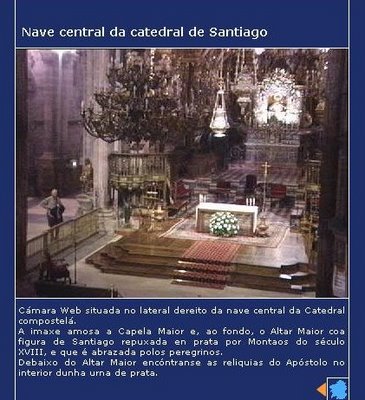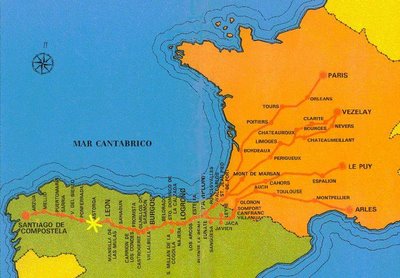A Coruña--The English Road
I couldn´t resist one more little trip today. I took the train an hour north to the port city of A Coruña. The 100 km distance between A Coruña and Santiago is called the English road because after 1339, this would have been the way the English pilgrims would come to Compostella. In the 12th century the English king, Henry II (didn´t you see the movie "Lion in Winter"?), traveled to Compostella along the same road that I took beginning in his French possession of Aquitaine. However, the English subsequently lost that territory and with the onset of the Hundred Years War with France in 1339, the land route across France and northern Spain was closed to English pilgrims. Consequently, Chaucer´s Wife of Bath and the autobiographer Margery Kempe would have boarded a ship in southern English (usually Portsmouth) and landed in A Coruña.
Today, the city is quite large, and full of monuments to interest the historic/literary minded. The medieval English pilgrim´s first sight would have been the great lighthouse on the point of the harbor. There has been a lighthouse on that point since pre-Roman times. The current impressive structure is called the Tower of Hercules; built in the early 1700s, it actually encases the 13th century structure that English pilgrims would have seen. Rounding the point, ships confronted the fort--Castille San Anton. Yes, another castle! It´s a 13th century fort that guarded the inner harbor. In the 16th century they began adding cannon that are still in place. Interestingly, the fort houses a museum of Celtic artifacts--there was (and still is) a considerable Celtic community in and around this harbor. The Englishman William Wey took the pilgrimage along this route in 1456, and he wrote that there were more than thirty English ships in the harbor on his arrival. This was true for me today--A Coruña is a favorite excursion cruse for English tourists. There was a huge luxury liner in the harbor that had landed hundereds of tourists from the British isles. Medieval pilgrims would have visited two important churches: the Church of Santiago and the Church of the Maria del Mar (Mary of the Ocean). The former was a great, square construction typical of the early 12th century--about 1120. The Marian church dates from the early 1200s and was a particular favorite of English travelers. William Wey and others remarked in their travel narratives that services in both Latin and English were available in the Chruch of Maria del Mar because a group of English Franciscans had built a residence beside the church to serve the many pilgrims from their native land.
Okay, that´s the history/literature lesson. I´ll just add that A Courña was an unexpectedly beautiful city. It is much larger than Compostella and the port was busy with trade and tourism. The massive and aptly named Tower of Hercules was fun to climb--yes, you can go to the top of this giant lighthouse and look out over the Atlantic (actually a little scary from its height). The sea breeze was fresh and salty, and with the endless horizon of the ocean on one side and the mountains of Spain on the other, the view was spectacular. It´s likewise amazing that this area has been constantly inhabited for more than three thousand years. My interest in medieval pilgrimage is only a moment in time to this place.
Well, lots of fun in A Coruña, and I´d recommend a trip there, but this evening I´m packing for my flight on Ryan Air to London. I will offer a few conclusions to my pilgrimage in my final few entries. ¡Hasta Luego!




